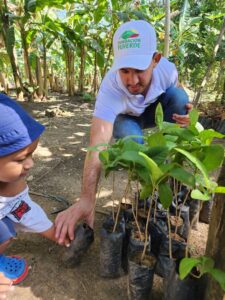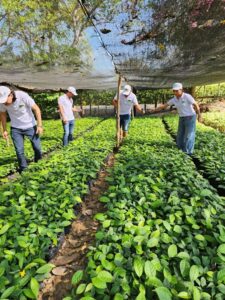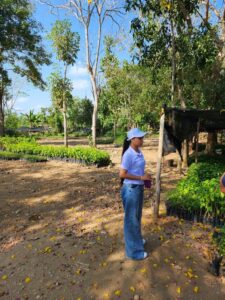HABITATS RESTORATION REPORT
- Starting Date: September 04, 2022
- Ending Date: May 31, 2023
GOAL
- Community restores 3,400ha of forest through reforestation with 35,000 trees of fast-growing native species, with emphasis on erosion control.
A1.2. Preparation of 10 tons of enriched organic compost to fertilize target soils with nutritional deficiencies.
-Methodology: To reduce costs, we use organic matter and organic waste collected from the surrounding forests and surrounding communities; the associated costs are for the purchase of fertilizers to enrich specific production lots due to nutritional needs detected in the soil analysis. Addition of lime and fertilizers in adequate amounts and proportions to correct the problems found in the soil analyzes carried out. Application of mycorrhizal-forming fungi (endo-and/or ectomycorrhizal) to improve the capacity of seedlings to absorb water and low-mobility nutrients in the soil, particularly phosphorus.
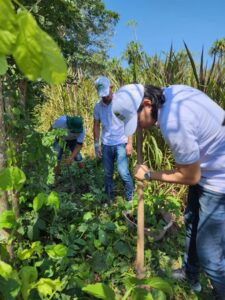
A1.3. Construction of 5 greenhouses with a capacity of 10,000 seedlings each (At least 90% of germination success expected); one greenhouse per target tree species.
-Methodology: 5 nurseries were built (one for each species of tree); They have an extension of 15m x 8m equivalent to 120m2 with a capacity of 10,000 seedlings. The bags to be used are 9cmx18cm, equivalent to 15 bags per meter of land, the germination beds are 5m long by 1 meter wide and 50cm is left between furrows to facilitate the passage of workers. Consideration is given to the area for capping, preparation of the ground and shaded area for storing items. 90% survival of each seedling. That is why 45,000 seedlings are planted, to obtain 40,000 healthy seedlings.
A1.4. Construction of 20 forest dams and grooves, to channel runoff and sedimentation, which cause erosion.
-Methodology: Construction of 20 dams and grooves with a 1.5% inclination to redirect excess runoff and forest sedimentation. Previous topographic analyzes to increase the drainage of rainwater runoff.
- How many trees were planted? > 35,000 trees
- How many hectares restored? 3,400ha
- What species were selected?
|
Arbol de Soria (Pseudoxandra atrata) |
|
Arbol del amanecer (Vochysia artantha) |
|
Palo rosa (Aniba rosodora) |
|
Huaorani; Ontumo (Pleurothyrium tomentellum) |
|
Corcuncho (Eschweilera integricalyx) |
- What percent of trees planted were native versus non-native trees (please attach a list of all species and numbers planted of each):
100% of the trees were native species.
|
Native species |
Number of trees planted |
|
Arbol de Soria (Pseudoxandra atrata) |
>7,500 |
|
Arbol del amanecer (Vochysia artantha) |
>7,500 |
|
Palo rosa (Aniba rosodora) |
>7,500 |
|
Huaorani; Ontumo (Pleurothyrium tomentellum) |
>7,500 |
|
Corcuncho (Eschweilera integricalyx) |
>7,500 |
- How are climate projections being taken into account? (ex. your site is projected to become drier and therefore you have selected species that require less water, etc.)
In the forests of the Sinú riverside in Colombia, it rains all year round, with sudden changes in temperature with thermal sensations of up to 40°C in the same day. This project proposes:
1.Construction of 5 greenhouses (1 for each species) to guarantee germination and protect the seedling in its early stages from the cutting effect of rain and attack by herbivorous animals.
2.There are no difficulties or investment in water supply or water retainers due to the natural abundance.
3.Given that the re-sowing of the seedling in its final geographical situation is carried out in degraded and deforested lands, the typical ‘shadow’ factor of the Sinú rainforests is not problems in terms of scarcity of sunlight.
4.A monitoring system is implemented where, among other variables, nutritional monitoring of each seedling is supervised based on the ‘climatic moment’: torrential rain or inclement sunlight.
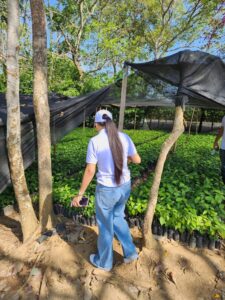
- Were there any extreme weather events that happened during this project? (E.g. heat waves, drought, heavy precipitation, floods)
There were delays in the work of transplanting seedlings to the final forest site due to unusual torrential rains, a product of climate change. Since we used 5 nurseries for planting and seedling development, they were safe from the shearing effect of the rains.
- Is there another workshop or activity planned?
– Overseeding, monitoring and traceability of > 35,000 seedlings planted at the final site. Use of small batches of 500 seedlings per supervisor (500 trained youth monitor batches planted as a final evaluation of the training).
OUTCOMES
- Conservation outcomes
– A wooded area in the Sinú River basin with an area of 3,400ha is reforested, by planting and transplanting > 35,000 threatened native trees of 5 threatened species (each).
-Deforestation rates in the target territory are reduced by 60%.
-The incidence of forest fires decreased by 95% in the period September2022-May/2023, compared to the same period in 2021.
-Increase in the conservation status of 5 threatened tree species in the Colombian Sinú forests.
-Local prohibitions on deforestation and forest burning are implemented for agricultural, livestock and mining activities
- Planting activities:
A2. Construction of 5 community nurseries with a capacity of at least 6,000 seedlings each.
A6. Construction of 10 forest fire break points to improve the coordination of forest fire extinction in the Zenú indigenous territory. Agreement with the regional fire department.
A7. Seed sowing, germination, growth and development of at least 30,000 seedlings in community nurseries.
A8. Sampling and conducting 50 soil analysis, prior to transplanting seedlings to the final site in the Sinú Forest; application of organic fertilizers when necessary.
A9. Seedling transplant to final site and monitoring of 30,000 transplanted seedlings, through a forest traceability system.
- Agreement/consent from indigenous communities (working agreement with communities, committees, and other local stakeholders)
This project is implemented in the ancestral territories of the Zenú indigenous community, in the Colombia. They cover an area of 18,000ha (Project map available), and we estimate the direct and indirect participation of 5,000 indigenous Zenú, trained directly and / or through conferences held in secondary schools in the area. We have the support of the Zenú administrative council, whose representatives participated in the writing of this proposal. The participation of the young indigenous population of the project is important to guarantee the sustainability of the conservation actions in the long term; We have registered and contacted volunteers from the Zenú indigenous community, for project activities, who participate in training, construction, monitoring and replanting of seedlings; and management of the environmental corporation. International organizations such as the regional secretariat of the IUCN have shown interest in the project, offering consultancy and academic material in the eventual implementation. The government of Colombia, through CORPOMAGDALENA, has been notified of the project and has shown interest in its eventual execution, depending on the approval of the project.
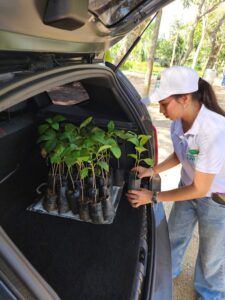
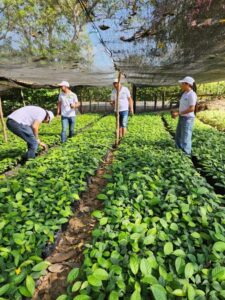
- How the gender dimensions are considered and measured for this project?
Gender inequalities are present in the Zenú indigenous community. The management of economic resources, decision-making on land use, land tenure and political participation have traditionally been male roles. Our project’s goal is to incorporate at least 200 benefited women in the training; 30 women in the entrepreneurship strengthening program. To do this, we use as a strategy:
(i) Have 4 women advisors (work team) in the technical part in the territory, so that they can contribute, from their vision, to the reduction of gender gaps.
(ii) Ensure the participation of 200 women in training to strengthen their knowledge and skills that allow them to empower themselves economically.
Achieve the training of 30 women in the production of agroforestry plants in nurseries, seedbed development, nursery management, reforestation, grafting technique, etc. Women have an active role in the implementation of the solution. They are decision makers on the use of their lands, they belong to the boards of directors, they participate in public consultations to define the application of the agroforestry system, and the type of species to plant. In addition, they are integrated into a local organization of producers and producers.
- Participation of children and youth?
The awareness of children is important in the Zenú indigenous territory where children are strengthened as guardians of the trees, to better understand the impact of their current habits on the environment. Our project has reserved an activity aimed at children and adolescents from 5 educational institutions in the region (12-18 years): The 4 workshops are held with groups of approximately 250 boys and girls. It is developed in 3 stages:
1.Awareness meetings
2.Publication of the virtual forest by uploading the drawings of the boys and girls in Powerpoint. 3.Planting days and monitoring.
Extension awareness meetings The facilitator visit the group of boys and girls to offer an educational and participatory workshop. The awareness workshop lasts 3 hours.
With two stages:
- Tree and its Ecosystem: Activities focused on recognizing the tree and its surroundings.
2.Impact on the tree: Identify the impact that human beings have on forests.
In the day that takes place outdoors, the girls and boys who participate plant a tree in their community or in their territory, or they participate in a field action in favor of the environment such as a visit to nurseries, hiking or activities of recycling.
- How is this proposed project addressing Sustainable Development Goals, national and regional priorities?
This project addresses the scope of SDG15 ‘Life on land ecosystems’ because it contributes to the sustainable management of 4,000ha of forests; fight against desertification through the planting of 40,000trees; stops land degradation by controlling 95% of water erosion; and prevents the loss of biodiversity associated with the Zenú indigenous territory. Our project contributes 40,000trees to the goal proposed by the Colombian Ministry of the Environment of planting 1,000,000trees by 2030.
By strengthening the conservation capacities of the Zenú indigenous community, we contributed to compliance with the ESCAZÚ agreement to prevent mining and civil concessions along 4,000ha of ecological corridors.
